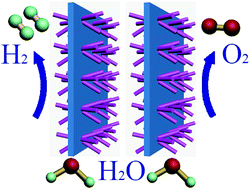Self-supported NiMo-based nanowire arrays as bifunctional electrocatalysts for full water splitting†
Abstract
Electrochemical water splitting has been considered as an efficient way for the production of clean hydrogen fuel. To achieve high efficiency and reduce the cost of electrolyzers, non-precious bifunctional electrocatalysts, which can operate in the same electrolyte, are highly required. Here, we report a facile method for synthesizing self-supported NiMo nitride nanowire arrays as high-performance, binder-free bifunctional electrocatalysts. The binder-free electrodes exhibit excellent catalytic activities with a current density of 10 mA cm−2 at overpotentials of 22 mV for the hydrogen evolution reaction and 230 mV for the oxygen evolution reaction, respectively. Remarkably, to drive a current density of 10 mA cm−2, the full water splitting system assembled with the self-supported nanowire arrays only needs a cell voltage of 1.507 V, significantly lower than that of the electrolyzer based on Pt/C and IrO2 catalysts (1.540 V). Furthermore, the full water splitting system assembled with the self-supported NiMo nitride nanowire arrays shows an outstanding durability with a negligible current change at a large current density of 370 mA cm−2 for 30 h continuous electrolysis. The results presented here demonstrate that the development of self-supported electrodes is an efficient way for fabricating a high-performance, low-cost, robust and stable full water splitting device.



 Please wait while we load your content...
Please wait while we load your content...